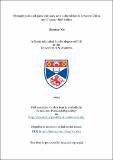Files in this item
Through pots and pans: culinary and cultural bonds between China and Japan, 1868-1980s
Item metadata
| dc.contributor.advisor | Lawson, Konrad M. | |
| dc.contributor.author | Xie, Zhentian | |
| dc.coverage.spatial | 284 | en_US |
| dc.date.accessioned | 2023-11-14T15:37:55Z | |
| dc.date.available | 2023-11-14T15:37:55Z | |
| dc.date.issued | 2023-11-29 | |
| dc.identifier.uri | https://hdl.handle.net/10023/28697 | |
| dc.description.abstract | Since the late 19th century, the ways of eating in China and Japan have become more similar than at any other time in history. Numerous shared elements have reshaped both countries' culinary culture. New dishes, skills and ingredients were created due to cultural interaction and mutual inspiration. Culinary exchange offers an often-overlooked perspective on the Sino-Japanese relationship and the development of East Asian regional bonds in modern times. While existing studies have explored the introduction of Chinese cuisine into Japan and its associations with empire and a post-war economic boom, this dissertation discusses how Pan-Asianism, and the Sino-Japanese relationship at its foundation, played a role in two-way culinary exchanges before and during the Second World War. Figures such as Zhou Zuoren, Marumoto Shōzō and Yamada Masahira attempted to use cuisine as a tool to recreate connections between China and Japan. This dissertation argues that, from 1868 to the 1980s, Sino-Japanese culinary exchanges helped formulate a foundation of shared experiences among a growing number of people from different groups on each side. The culinary bond formed by this common experience continued after the collapse of wartime Pan-Asianist ambitions, and, in turn, significantly reshaped the development of modern Chinese and Japanese cuisine in a postwar context marked by divergent paths in relation to the relative impact of women’s cooking role and domestic cuisine as key agents in this culinary interaction. Furthermore, this dissertation has demonstrated that both cuisines exhibited a process of internalizing each other’s culinary elements, which contributed to their uniqueness within the global expansion of mid-cuisine. Using cuisine as the agent, this dissertation provides a reconsideration of the Sino-Japanese relationship alongside its political, economic, and military dimensions, focusing on people's daily life and ideas under the intense communication between China and Japan in the early and mid-20th century. | en_US |
| dc.language.iso | en | en_US |
| dc.subject.lcc | GT2853A78X5 | |
| dc.subject.lcsh | Cooking, Chinese--History | en |
| dc.subject.lcsh | Cooking, Japanese--History | en |
| dc.subject.lcsh | Food habits--China--History | en |
| dc.subject.lcsh | Food habits--Japan--History | en |
| dc.subject.lcsh | China--Relations--Japan--History | en |
| dc.subject.lcsh | Japan--Relations--China--History | en |
| dc.title | Through pots and pans: culinary and cultural bonds between China and Japan, 1868-1980s | en_US |
| dc.type | Thesis | en_US |
| dc.contributor.sponsor | Great Britain Sasakawa Foundation | en_US |
| dc.type.qualificationlevel | Doctoral | en_US |
| dc.type.qualificationname | PhD Doctor of Philosophy | en_US |
| dc.publisher.institution | The University of St Andrews | en_US |
| dc.identifier.doi | https://doi.org/10.17630/sta/661 | |
| dc.identifier.grantnumber | 19636 | en_US |
This item appears in the following Collection(s)
Items in the St Andrews Research Repository are protected by copyright, with all rights reserved, unless otherwise indicated.

